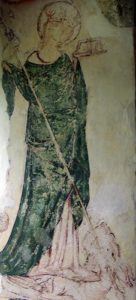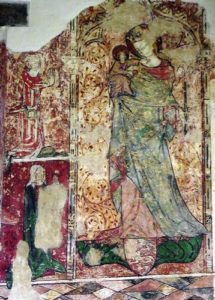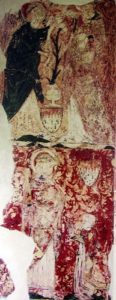The church of St Peter ad Vincula inSouth Newington has some of the best preserved medieval wall paintings in Oxfordshire, if not England. I have written a separate description of the church. This just gives details of the wall paintings.
NORTH AISLE
This was originally the chantry chapel of the Giffard family who embellished the walls with paintings dating from around 1330. They were a devotional expression as well as a statement of political affiliation and family status. The paintings were created using linseed oil on plaster. This slowed the drying process making it very expensive but ensured the depth of colour. It is a most unusual technique and only Westminster Abbey has paintings of similar quality.
The first painting on the left is the Martyrdom of Thomas a Becket. This is a remarkable survival as many of these paintings were destroyed by orders from Henry VIII who disliked being reminded of the church defying the crown. This survived as it was covered by a later painting of St George and the Dragon. Becket in a red garment, is kneeling in front of an altar and is confronted by the four knights. The blow of the first knight is fended off by the white robed priest. The second knight strikes a fatal blow and succeeds in removing the top of Becket’s head. The third knight has his sword ready to strike while the fourth is unsheathing his sword.
Next to the Becket martyrdom is the execution of Thomas Plantagenet, 2nd Earl of Lancaster in 1322 for his role in the murder of Edward II’s favourite Piers Gaveston. Lancaster is kneeling with blood spouting from wounds on his neck. His executioner behind him, poised to strike another blow. This is the only known example of this scene. After his death, miracles were reported at his tomb and Edward III was petitioned three times for him to be made a saint. It seems likely that this painting was part of the campaign to have him canonised by the Giffards who had been followers of Lancaster.
On a window splay is a painting of the Annunciation with Gabriel in a dark green mantle appearing to the Virgin Mary. Between the two figures is a lily in a vase standing atop an heraldic shield with the Mortayne coat of arms possibly those of Margaret Mortayne, wife of Thomas Gifford.
Below is a depiction of St James.
The final picture in the north aisle next to the chancel arch is the Virgin and Child. This is a beautiful painting set under a Gothic arch decorated with scrolls. In her left hand, the Virgin is holding a fleur de lys. The Christ Child is holding an apple, signifying his acceptance of the sins of the world. At the bottom is a shield with the three leopards from the Gifford coat of arms. The kneeling figures on the left are possibly John Gifford and his wife Lucy Morteyn who may have been the donors.
CHANCEL
On the south side of the east window in the chancel is a painting of Margaret of Antioch killing the dragon that tried to swallow here. This may have been balanced by a (now long gone) painting of St Catherine on the north side.
NORTH ARCADE OF THE NAVE
The paintings above the north arcade are 15thC and a much more rustic style and are great fun. The Passion is depicted as a series of comic book style pictures beginning with Christ's entry into Jerusalem on a donkey. This is followed by the Garden of Gethsemane with Christ holding a cup and two sleeping disciple. This is followed by the betrayal and arrest. The next series of three pictures begins with the flagellation with Christ covered with spots of blood, which makes him look as if he has chicken pox. He is then shown carrying his cross with his mother standing watching. The third picture is the Crucifixion. The next pictures are badly damaged but probably represent the entombment. The next shows Christ rising from the dead (the tomb looks remarkably like a bath… ) with the sleeping figures of the Roman soldiers. The final scene again is in poor condition but would be the Ascension into Heaven.
At the base of the arches is a painting of what is described as the 'Trinity Tree'. A three branched tree has a shield with a cross and the instruments of the Passion in the corners. This is the only church with paintings like this.
At the east end, high on the wall is the remains of a painting of St Michael weighing souls at the Last Judgement with the Virgin watching. Below are more shields.
CHANCEL ARCH
Above the chancel arch is the remains of a Doom painting but it is in very poor condition and little detail can be seen. There are plans to restore this if finance is available.
The church was locked when we visited but there is a list of key holders on the notice board.
For those with walking difficulties, there are steps down into the church.










